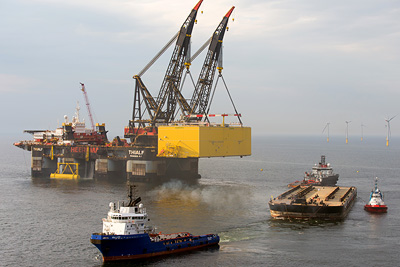Siemens successfully installs third HVDC platform in the North Sea for TenneT

Platform for North Sea grid connection HelWin2 successfully installed: The heavy-lift crane ship Thialf hoists the HelWin2 platform from the transport barge onto the previously prepared supporting baseframe. The HelWin2 grid connection will transmit offshore-generated wind power to land for some 700,000 German households.
Siemens has completed installation of the offshore platform for the direct-current connection HelWin2. Working under contract from the German-Dutch grid operator TenneT, Siemens has thus achieved a decisive milestone of the German grid connection projects. “We have now installed three high-tech platforms for TenneT in the North Sea. The HelWin2 project is now in the homestretch to begin operation in the coming year,” says Jan Mrosik, CEO of the Power Transmission and Smart Grid Divisions of Siemens AG. “We have achieved one more major interim milestone, and are step by step accomplishing the German government's offshore expansion goals”, says Lex Hartman, member of TenneT's executive board.
The newly installed HelWin2 platform lies 35 km north of the island after which it was named, Heligoland, directly adjacent to the HelWin1 platform Siemens successfully erected earlier in August 2013. Earlier this year in April Siemens already erected the BorWin2 platform off the coast of Borkum.
All told, Siemens builds five North Sea grid connections for TenneT. The first four are to begin commercial operation successively over the second half of 2014 and the first half of 2015, and in sum total provide transmission capacity of over 2.9 gigawatts. The fifth connection recently ordered this year, BorWin3, is to be ready for operation in 2019.
Using the Siemens technology installed on the platforms, the alternating current power generated by the wind turbines is transformed into direct current for efficient transmission to the mainland. At the associated land-based stations, the electricity generated by the connected wind farms is converted back into the alternating current power required for feeding into the transmission grid. Thanks to Siemens' low-loss high-voltage direct current (HVDC) technology, transmission losses are less than four percent. The platforms are designed to operate for decades in the rough North Sea conditions, and are fully automated.
The HelWin2 platform was constructed and installed by Heerema. The marine and land-based cabling were supplied and laid by the cable specialist Prysmian Group.
HVDC solutions and the associated service activities are part of Siemens' Environmental Portfolio. Around 43 percent of the company's revenues are generated by green products and solutions. That makes Siemens one of the world's leading providers of eco-friendly technology.
This press release and related press photos and datasheets on offshore platforms are available along with other information at: www.siemens.com/press/x-win
The Siemens Energy Sector is the world's leading supplier of a complete spectrum of products, services and solutions for power generation in thermal power plants and using renewables, power transmission in grids and for the extraction, processing and transport of oil and gas. In fiscal year 2013 (ended September 30) the Energy Sector had revenues of EUR 26.6 billion, received new orders totaling approximately EUR 28.8 billion, and posted a profit of some EUR 2 billion. On Monday, September 30, 2013, the Energy Sector had a workforce of approximately 83,500. Further information is available at: http://www.siemens.com/energy
Reference Number: EPT201407056e
Contact
Mr. Torsten Wolf
Energy Sector
Siemens AG
Freyeslebenstr. 1
91058 Erlangen
Germany
Tel: +49 (9131) 18-82532
All latest news from the category: Corporate News
Newest articles

Security vulnerability in browser interface
… allows computer access via graphics card. Researchers at Graz University of Technology were successful with three different side-channel attacks on graphics cards via the WebGPU browser interface. The attacks…

A closer look at mechanochemistry
Ferdi Schüth and his team at the Max Planck Institut für Kohlenforschung in Mülheim/Germany have been studying the phenomena of mechanochemistry for several years. But what actually happens at the…

Severe Vulnerabilities Discovered in Software to Protect Internet Routing
A research team from the National Research Center for Applied Cybersecurity ATHENE led by Prof. Dr. Haya Schulmann has uncovered 18 vulnerabilities in crucial software components of Resource Public Key…





















